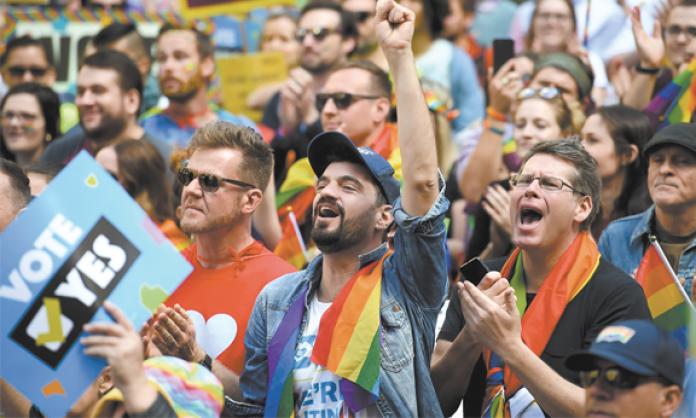As the pre-game entertainment was getting under way before the NRL grand final, Sydney Morning Herald columnist Peter FitzSimons was sitting next to a nervous Ian Roberts. Roberts, FitzSimons said, was “the toughest footballer ever to put on a boot”. He is also the only professional male footballer in Australia to have come out as gay, which he did in 1995.
The controversy over the NRL decision to have US artist Macklemore perform “Same Love” to the grand final crowd had been front page news all week. “So how would this pure rugby league crowd react, these folk tried and true, these truest of blue, in this most working class of games?”, FitzSimons asked. “Would they boo? Would they hiss? Turn their backs? If so, it would be a disaster, and vindication for the critics.”
The song begins.
“The crowd simply EXPLODES”, FitzSimons wrote. “They stomp they cheer, they sing along, they turn the lights of their iPhones on, and wave them in rhythm, instantly turning the arena into a massive sparkling wonderland.”
Ian Roberts holds the hand of his partner, Daniel, and weeps.
FitzSimons continued: “This is how far rugby league has come since the days where ‘yer a poofta’, was the ultimate putdown for anyone who was different. As Macklemore gets to the end of the song and the league fans stand on their seats and cheer themselves hoarse, Roberts weeps some more.”
It’s an amazing story, and a striking illustration of just how much the years-long marriage equality campaign has transformed social attitudes.
All indications are that the Yes campaign is on track for a smashing victory. The Australian Bureau of Statistics estimated that by 29 September it had received postal surveys from 57.5 per cent of voters – 9.2 million people.
A ReachTEL poll reported 64.3 percent of respondents had sent back their ballot and voted Yes, compared with 15.5 percent who had voted No.
If ReachTEL’s figures are remotely in the ballpark, it is a stunning result – wildly better in terms of both turnout and the percentage for Yes than even the most optimistic on the Yes side had hoped for.
The polls that report a smaller Yes vote, and indicate that a smaller number of people have voted, still point to a historic landslide in favour of Yes – something in the order or 2 to 1 – and a very high turnout.
Pollster John Stirton told Fairfax Media, “It’s very hard to see how the No case could win from here unless an awful lot of people are straight-out lying”.
It is worth pausing to consider how monumental an achievement this is.
Twenty years ago, homosexuality was still criminalised in Tasmania. When John Howard legislated to ban same sex marriage in 2004, he was backed by the Labor Party; Newspoll indicated public support for marriage equality was only 38 percent. Only six years ago, in 2011, opposition to marriage equality was still bipartisan policy. Even after Labor changed its position, it did not – and does not today – bind parliamentarians to vote for equality.
How much has changed. Over the past month, the Yes campaign has brought unprecedented numbers into the streets. When 20,000 demonstrated in Melbourne on 26 August, it was far and away the biggest gay rights demonstration in Australian history. That record lasted for little over a week before it was eclipsed by a mammoth 50,000-strong rally in Sydney. Across the country, thousands have rallied in support of a Yes vote in capital cities, and hundreds in innumerable regional cities and towns.
Organisations such as GetUp! and the Victorian Trades Hall have organised door knocking and cold call phoning to get out the Yes vote. GetUp! estimates that it called more than 650,000 people in the last month. Trades Hall in Melbourne has been overrun with volunteers since the campaign began.
Across the country, there are reports of people organising informal discussions in their homes to try to convince the undecided why they should vote Yes, and having dozens of people turn up. Accounts are everywhere of people who have taken the time to convince their conservative parents or grandparents or friends or neighbours to vote Yes.
In the inner cities, it is impossible to walk down a shopping strip without seeing endless cafes, small businesses, residential houses and street posts adorned with rainbow coloured signs and flags.
But in spite of this immense campaign, which now amounts to the biggest social movement in Australia since that against the Iraq war in 2003, there are still doubters and worrywarts, of both the sincere and insincere variety.
The central argument has been that the huge mobilisations on the streets and the endless examples of vigorous campaigning are just the mobilisation of a vocal minority which either can’t get through to or is outright alienating the conservative majority.
Conservative columnists have churned out innumerable articles about how the Yes campaign, with its allegedly bullying approach, is turning people against it.
Others, from a possibly less cynical perspective, are in a state of constant worry that the Yes campaign is screwing it all up. According to one article in the Australian, the tens of thousands of people who took to the streets were only driving people away from the cause. Irfan Yusuf, writing at Crikey, lamented, “The Yes camp’s hostility to religion is losing them votes”.
Even left wing commentators such as Guy Rundle and Helen Razer have repeatedly raised the alarm that the Yes campaign is doing it all wrong. According to the usually excellent Razer, writing on 11 September, “a No to the question of marriage equality now seems very likely”.
A few weeks earlier, she had written, “If we continue to hear endorsement from celebrities, as we did throughout Clinton’s campaign … what we might very well find is a No vote that defies all previous polls”.
This is tilting at windmills on an epic scale. The Yes campaign isn’t Hillary Clinton’s liberalism for billionaires, or the UK bankers who backed Remain. It isn’t a campaign to defend the interests of the 1 percent wrapped in a cynical garb of identity politics or liberal internationalism. It’s a basic fight for democratic rights and equality.
It’s true that the Yes campaign is backed by huge swathes of the Australian establishment, but that’s because they are craven opportunists who can see which way the wind is blowing, not because marriage equality is a plot by the liberal elite to keep the masses down.
Panic about the polls being wrong – look at Brexit and Trump! – are fatuous. In those cases, the polls weren’t all that wrong anyhow – they were out by 1 or 2 percent at most. But never have polls been so misleading as to turn a 2 to 1 majority into defeat.
In fact, the utter failure of the No campaign to mobilise an “anti-establishment” vote tells us something both important and heartening about the Brexit and Trump results. The Brexit/Trump votes prove that neoliberal economics is rightly hated. It’s true they also show that one particular reactionary social ideology – racism – is deeply entrenched. That’s backed up by the appalling attitudes towards refugees shown in opinion polls in Australia. But the Yes campaign demonstrates that it is possible to win a decisive majority for a progressive social agenda on other issues.
Instead of worrying, in spite of all evidence to the contrary, that the left is losing, it would be better to start thinking about the potential positive consequences of what is shaping up to be a monumental rout of right wing conservatism.
The most important thing the polls tell us is that the so-called silent majority of social conservatives does not exist. It is a right wing myth. The thousands who have taken to the streets in support of LGBTI rights are not an out of touch minority living in a liberal bubble – they speak for the overwhelming majority of the population.
The real out of touch elite are the stuffy, old, male, white, well-off conservatives, pining for an era when gays and lesbians (and workers and women and non-whites) knew their place, and no-one questioned the right of the respectable rich to dictate morality to the masses from their house on the hill.
Tony Abbott’s appeal to conservatives to vote No “if you oppose political correctness” – which is shorthand for anything liberal or progressive – was an attempt to mobilise the middle class and working class conservative base behind the politics of a broad ruling class conservatism that has dominated Australian politics since invasion. If the polls are to be believed, this campaign is proving that the era when that was an effective politics is finished. The constituency Abbott is appealing to exists, but it is a minority, and a shrinking one.
We already knew, after the 2014 budget, that the neoliberal economic politics of the Abbott era were opposed by a big majority. Here is proof you can construct a clear majority against the conservative right’s social agenda as well.
We need to push on, obviously, and fight until the final day to get every Yes vote out. But let’s do it with a spring in our step. The left is winning for once. This is a moment to celebrate. And to push the right as far back as we can.









